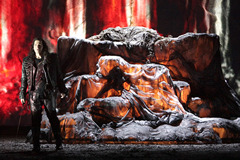| Opera Reviews | 8 May 2024 |
The La Scala Ring continues with Siegfriedby Silvia Luraghi |
|
| Wagner: Siegfried Teatro alla Scala, Milan 18 November 2012 |
|
|
Visually, the production was very compelling, and special mention is deserved for lighting designer Enrico Bagnoli, who also collaborated with Cassier on the set designs. The setting for the first act featured a movable metal structure which represented Mime's workshop, metal being the key concept for this first act, as the sword Notung is intended to be its protagonist. In the second act, young Siegfried wanders in a dim forest, with the high tree trunks also shining as silver metal. Fafner turns into a highly abstract dragon, represented by dancers hidden behind a waving cloth. When Siegfried kills Fafner the dancers surround him in a protective attitude: they represent the strength of the Nibelung's ring, as was already hinted to in Rheingold. Red threads drop on the stage at the dragon's and at Mime's death, a feature of continuity with Die Walküre. At the opening of the third act, Erda appears in an impressive long gown against a grayish background, and Wotan comes in accompanied by a flock of crowds. The setting changes again to show the mountain where Brünnhilde was left sleeping at the end of Die Walküre: Siegfried climbs it, thus introducing the final duet of the opera. Daniel Barenboim conducted with commitment, and the orchestra responded with skill. The vocal side was much less compelling. Lance Ryan in the title role was at odds with the demanding score: he could not produce enough volume and sounded tired in the last act, in which he had some intonation problems in the final duet. Terje Stensvold was an idiomatic, if not impressive, Wanderer, while the best among the male singers was certainly Peter Bronder as Mime. Anna Larson as Erda displayed a nicely colored but small sized voice. At the last performance, Iréne Theorin took up the role of Brünnhilde (sung at the other performances by Nina Stemme). Her sizable and ringing soprano did not sound especially well trained, top notes were often out of control and she had to force her voice. Hopefully, it was only the matter of a bad evening, as this singer is scheduled to sing in the whole Ring cycle next spring. |
|
| Text ©
Silvia Luraghi Photo © Brescia/Amisano © Teatro alla Scala |

 Siegfried,
the third installment of Wagner's Ring, concluded the 2011-2012 season
at La Scala last Sunday. This was also the third part of the Guy Cassier
production, whose previous parts Das Rheingold and Die Walküre
were shown in preceding seasons. Götterdämmerung will
follow in May and immediately thereafter the whole cycle will be performed,
as a celebration for the Wagner year.
Siegfried,
the third installment of Wagner's Ring, concluded the 2011-2012 season
at La Scala last Sunday. This was also the third part of the Guy Cassier
production, whose previous parts Das Rheingold and Die Walküre
were shown in preceding seasons. Götterdämmerung will
follow in May and immediately thereafter the whole cycle will be performed,
as a celebration for the Wagner year.





